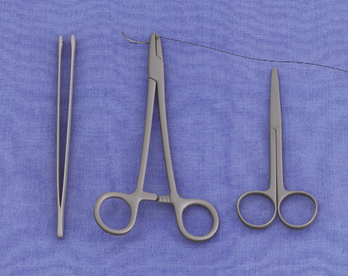Chapter 15 First- and Second-Degree Laceration Repair
Equipment
The instruments required for a perineal repair include a needle driver and a tissue forceps such as a Russian forceps to grasp the needle while suturing (Figure 15-1). To prevent a needle stick injury, avoid using your fingers to grasp the needle during the entire repair. Use 3-O chromic gut or absorbable braided polymer suture such as Dexon or Vicryl for the repair. For deeper second-degree or greater lacerations, use absorbable braided polymers for the entire repair.
Key steps
1. The vaginal apex, posterior fourchette (PF), and perineal apex are identified (Figure 15-2). It is critical that the two sides of the posterior fourchette are approximated during the repair. Consider performing a rectal exam with a double-gloved hand to confirm the thickness of the rectovaginal septum, then discard the outer glove. Inspect the full depth of the laceration or episiotomy to clearly identify the tissue layers and the degree of the laceration.
Stay updated, free articles. Join our Telegram channel

Full access? Get Clinical Tree



